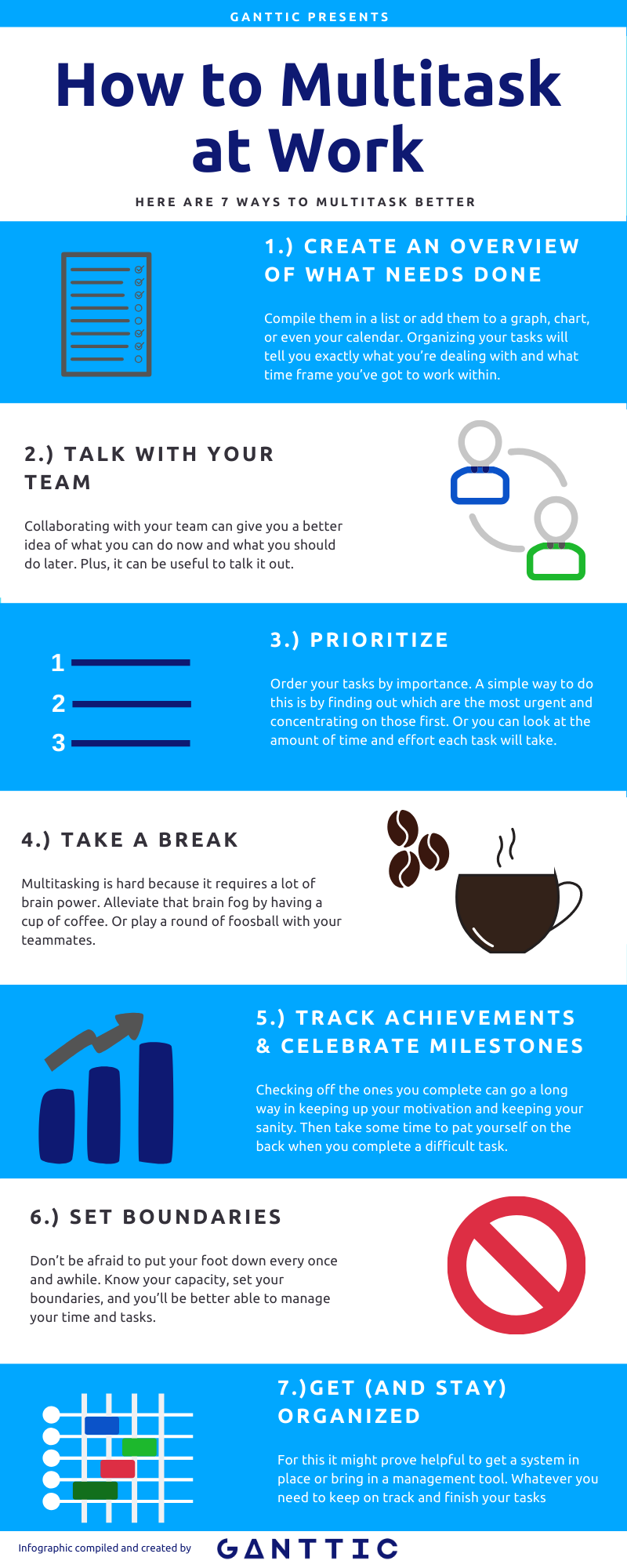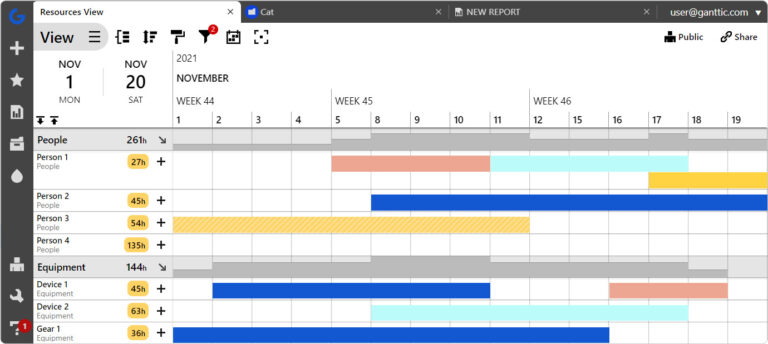There’s a million things we need to do everyday. And in order to get all these done, we’re often stuck doing many things at the same time. So to help you be more productive, we created an infographic with 7 tips on how to multitask at work.
A Balancing Act
Have you ever had to do two things at the same time? And yes, skimming this article while also nodding along to Karen in Accounting’s anecdotes about her pet snake counts.
Even with all the evidence against multitasking, for better or worse, scheduling and planning multiple tasks at the same time is still a mainstay in the modern work environment.
So because juggling multiple work tasks is something we all will have to deal with, we want to make it easier for you. By implementing these techniques you’ll be able to be more productive whilst on the job, but also feel less stressed in your everyday life as well.
How to Multitask at Work
Find out how to multitask better with our detailed infographic. Just remember these 7 steps to handle simultaneous tasks with skill and ease:
- Create an overview of what needs to be done
- Talk with your team
- Prioritize work tasks
- Take a break
- Track achievements and celebrate milestones
- Set boundaries
- Get (and stay) organized

1. Create an Overview
When you’re dealing with several tasks, the first thing you need to do is get an overview of all your tasks. Compile them in a list or add them to a graph, chart, or even your calendar. Organizing your tasks will tell you exactly what you’re dealing with and what time frame you’ve got to work within.
This is an important step, and while you may automatically feel rushed, try to slow down. Take the time really to think about what needs to be done, and if it’s even possible at this moment with the resources you’ve got. You may find there’s a ton of other tasks which need to be completed first, so these dependencies will be the natural starting point.
Seeing your tasks all laid out will help you get a better grasp on the situation and will aid in making more informed decisions.
2. Talk with your Team
Once you see all your tasks laid out in front of you, you’ll need to make some tough decisions. One of these is figuring out what to do first. This can be based on a number of things. Such as the timeframe. If one task is scheduled to end before the other, it’s common sense to concentrate on the one with the closer deadline.
But it’s possible that the nearest task isn’t the most imperative. So reaching out to your team or your boss might be an easy solution to decide where to start. Or maybe they’ll contact you when something goes wrong.
For example, let’s say you are working on two different tasks: uploading products into your online storefront and figuring out your weekly marketing budget. But maybe Denise in logistics informs you that your product’s shipment was delayed. That automatically delays restocking your store, since the dependencies for your task are put on hold. Though it does make it easier to decide what you need to focus on first.
Collaborating and communicating with your team can give you a better idea of what you can do now and what you should do later. But it’s also useful to sometimes talk it out. Even if they can’t give you specific info on what to focus on first, they can give you advice or tips. And just like making a list, it might be helpful to just lay everything out so you can see your tasks in a different light.
3. Prioritize Work Tasks
When you have a better idea of what your tasks are and you’ve run things by your colleagues or boss, you might want to consider ordering your tasks by importance. A simple way to do that is by finding out which are the most urgent and concentrating on those first. Kanban boards can be a helpful way to reprioritize projects and tasks.
Or you can look at the amount of time and effort each task will take. It’s often a good idea to start with those, even if their deadlines are further down the line. This will keep you from scrambling at the last minute to finish those tasks up. And it can be positive to spend some time away and come back to them later. That way you have a fresh perspective when you dive back in.
4. Take a Break
Multitasking is hard because it requires a lot of brain power. Constantly switching between tasks is mentally exhausting and difficult for some to overcome. A way to alleviate that brain fog is to take a break. Have a cup of coffee. Or play a round of foosball with your teammates.
Though it may seem counterproductive, there’s a lot of science behind breaks. Doing so helps you to be more motivated, prevents mental exhaustion, and enhances the creative process. Take a walk, change your environment, or even just sit and daydream.
However you choose to unwind, make sure that you schedule in that break. Or else you might forget to take one and your productivity could be worse.
5. Track your Progress and Celebrate Achievements
Dealing with multiple simultaneous tasks can be nerve-racking and tense. Checking off the ones you complete can go a long way in keeping up your motivation and keeping your sanity. Doing that the old fashioned way, with paper and pencil, is one consistently satisfying option. Or you can upgrade a little with dedicated software for project management.
However, you wish to track your progress, take the time to not only tick off what you’ve accomplished, but also pat yourself on the back when you complete a difficult task. Don’t rush into starting the next one right away. Reflect on what you’ve done and enjoy the moment of elation before you hit the ground running on another project. This will help clear your mind and reset your focus to the new task on hand. It can also help you from feeling burnt out.
6. Set Boundaries
When you’re stressed out, you don’t think as clearly. That means that when you’re juggling your various tasks, there’s a danger in spreading yourself even further. Especially if you already have a hard time saying, “no.”
Don’t be afraid to put your foot down every once and awhile. If you’re already stretched too thin, then there’s no reason to agree to take on even more responsibilities. Know your capacity, set your boundaries, and you’ll be better able to manage your time and tasks.
7. Get (and Stay!) Organized
Once you’re able to get your tasks in order and start working through them, you’ll get to the hardest part: keeping on track and staying organized enough to finish them! For this it might prove helpful to get a system in place or bring in a management tool. Something that will keep your resources and project portfolio straight.
One that has easy sharing and collaborative abilities so you can keep in touch with your team. Plus, be on the lookout for something that gives an overview of all your tasks and dependencies and helps you see upcoming deadlines or milestones. You’ll want something that will not only help you get organized, but one that will keep you organized. That way nothing will stop you from conquering any number of tasks you may encounter.
Master Multiple Tasks

As frustrating as it is to deal with two things simultaneously, there’s also a silver lining. Taking a break from one task and focusing on another can help bring clarity or a new perspective to the initial activity. However, that doesn’t mean that managing multiple tasks is easy.
Learning how to multitask is really about finding a balance of techniques that work for you. But don’t be afraid to ask for help every once and awhile. Whether that comes from your team or a piece of software, you’ll know that you’ll have the support you need. And the tips and tools to become the ultimate taskmaster.